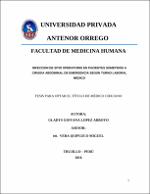Mostrar el registro sencillo del ítem
Infección de sitio operatorio en pacientes sometidos a cirugía abdominal de emergencia según turno laboral médico
| dc.contributor.advisor | Vera Quipuzco Miguel | |
| dc.contributor.author | Lopez Arroyo Gladys Giovana | |
| dc.creator | Lopez Arroyo Gladys Giovana | |
| dc.date.accessioned | 2017-01-24T20:06:59Z | |
| dc.date.available | 2017-01-24T20:06:59Z | |
| dc.date.issued | 2017 | |
| dc.identifier.uri | https://hdl.handle.net/20.500.12759/2244 | |
| dc.description.abstract | OBJETIVO: Determinar si la incidencia de infección de sitio operatorio en pacientes sometidos a cirugía abdominal de emergencia en el turno laboral medico nocturno es mayor que en el diurno en el Hospital Belén de Trujillo. MATERIAL Y MÉTODO: Se realizó un estudio observacional, analítico, de cohortes retrospectivas, que evaluó 278 pacientes distribuidos en dos grupos, grupo de turno laboral nocturno: 141 pacientes y grupo de turno laboral diurno: 137 pacientes. RESULTADOS: La edad promedio global fue 38,39 ± 18,04 años; los promedios en los grupos del turno laboral nocturno y diurno fueron 37,93 ± 17,91años y 38,86 ± 18,23 años respectivamente (p > 0,05); el 48,94% de los pacientes en el grupo de turno laboral nocturno correspondieron al sexo masculino y en el grupo diurno lo constituyeron el 52,55% de los pacientes (p > 0,05). La incidencia de ISO en el grupo nocturno fue 15,60% y en el grupo diurno fue 8,03%, con un RR = 2,12 IC 95% [1,34 – 3,34] (p < 0,05); en relación al tipo de ISO, se observó que el tipo que predominó fue el superficial con 77,27% en el grupo nocturno y del 81,82% en el grupo diurno (p > 0,05). CONCLUSIONES: El turno laboral en el que se operan los pacientes con algún tipo de cirugía abdominal de emergencia influye para la presencia de ISO en 2,12 veces más. | es_PE |
| dc.description.abstract | OBJECTIVE: To determine whether the incidence of surgical site infection in patients undergoing emergency abdominal surgery in the medical work night shift is greater than in the daytime in the Hospital Belen de Trujillo. MATERIAL AND METHODS: We conducted an observational, analytical, retrospective cohort study, which evaluated 278 patients divided into two groups, a group of night work shift: 141 patients and daytime work shift group: 137 patients. RESULTS: The overall mean age was 38.39 ± 18.04 years; group means in the night and daytime work shift were 37.93 ± 17,91 years and 38.86 ± 18.23 years, respectively (p > 0.05); the 48.94% of patients in the group of night shift work were male and in the daytime group is constituted 52.55% of patients (p > 0.05). The incidence of SSI in the night group was 15.60% and in the daytime group was 8.03%, with a RR = 2.12 95% CI [1.34 to 3.34] (p < 0.05); in relation to the type of SSI, it was observed that the predominant type was the surface with 77.27% in the overnight group and 81.82% in the daytime group (p > 0.05). CONCLUSIONS: The night work shift in patients operated with some type of emergency abdominal surgery influences for the presence of SSI at 2.12 times. | en_US |
| dc.description.uri | Tesis | es_PE |
| dc.format | application/pdf | es_PE |
| dc.language.iso | spa | es_PE |
| dc.publisher | Universidad Privada Antenor Orrego - UPAO | es_PE |
| dc.relation.ispartofseries | T_MED.HUMA_1836 | |
| dc.rights | info:eu-repo/semantics/openAccess | es_PE |
| dc.source | Universidad Privada Antenor Orrego | es_PE |
| dc.source | Repositorio Institucional - UPAO | es_PE |
| dc.subject | Infección de sitio operatorio | es_PE |
| dc.subject | Cirugía abdominal de emergencia | es_PE |
| dc.title | Infección de sitio operatorio en pacientes sometidos a cirugía abdominal de emergencia según turno laboral médico | es_PE |
| dc.type | info:eu-repo/semantics/bachelorThesis | es_PE |
| thesis.degree.level | Título Profesional | es_PE |
| thesis.degree.grantor | Universidad Privada Antenor Orrego. Facultad de Medicina Humana | es_PE |
| thesis.degree.name | Médico Cirujano | es_PE |
| thesis.degree.discipline | Medicina Humana | es_PE |
Ficheros en el ítem
Este ítem aparece en la(s) siguiente(s) colección(es)
-
Medicina Humana [2739]

